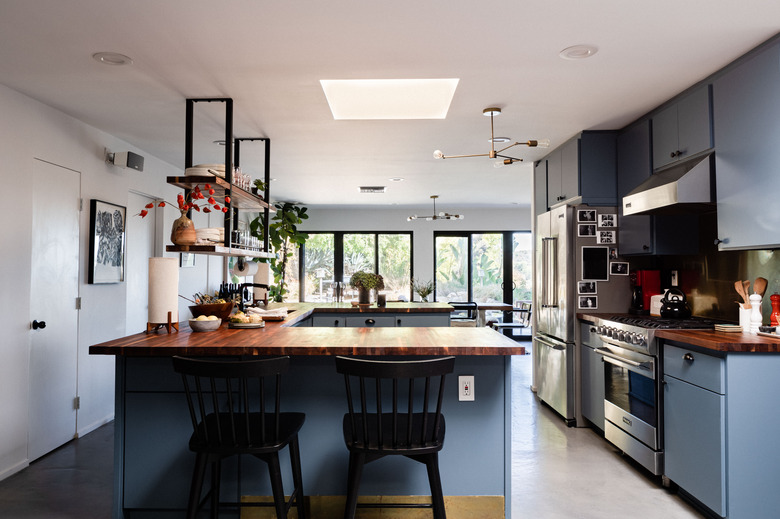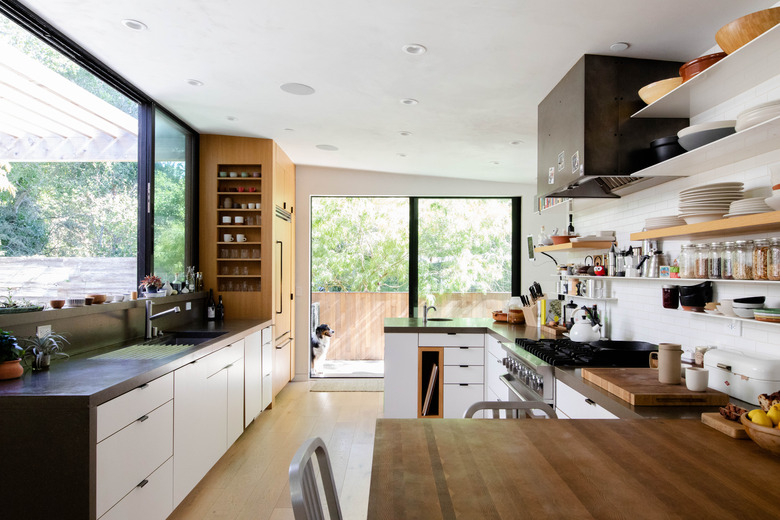How To Repair Butcher Block Countertop
Butcher block countertops can last for decades with proper care, but in a well-used kitchen, they may require more maintenance than the average laminate, stone or resin countertop. On the bright side, it's easier to repair a butcher block countertop than, for instance, chipped granite or laminate that's coming apart and fading in some areas. Butcher block cracks, burn marks and stains can all be repaired with wax, sandpaper and food-safe stain removers before oiling the entire countertop for added protection.
Treat the Small Problems First
Treat the Small Problems First
Since butcher block countertops are made of wood, they're susceptible to stains, burn marks and plenty of scratches. Each of these issues is relatively minor when you're planning to refinish the entire countertop.
Even if the damage is limited to a small area, it's a good idea to clean and reseal the entire countertop after treating the affected spots, as this type of countertop requires resealing from time to time to protect the wood. For any amount of sanding, wear a dust mask and eye protection to prevent airway or eye irritation.
- Treat stains such as those left by wine or fruit juice by dabbing them with hydrogen peroxide. Do your best to keep the peroxide on only the stained areas, as peroxide could bleach the surrounding wood. Blot the area with paper towels to lift the liquid after a few minutes.
- For a safer alternative stain lifter, mix just enough water into a few tablespoons of table salt to make a paste. Rub the paste over the stain. The wet salt scrubs minor stains away while lifting the staining substance out of the countertop, according to kitchen-equipment manufacturer John Boos.
- Sand burn marks off the butcher block countertop with 60- or 100-grit sandpaper or a sanding sponge, working in the direction of the grain. Apply light pressure and run your bare hand over the sanded area frequently to ensure you don't create a dip in the countertop. Wipe the dust away from the surrounding area with a soft, damp cloth. If the area feels rough at all, sand a little more with a 220-grit sandpaper, applying as little pressure as possible.
- Sand minor scrapes, scratches and knife marks with a 220-grit sandpaper, working in the direction of the wood grain. Check your work frequently to avoid oversanding, which could cause a dip in the surface.
Control Those Cracks
Control Those Cracks
A crack or split in a butcher-block countertop could become worse if left as is. The bigger problem is that food particles, residues and liquids traveling into that crack are practically impossible to remove and could become a health issue if you prep and cut foods on that part of the counter.
Seal those minor splits and cracks with paraffin wax or a food-safe wood glue. Titebond, for instance, notes that its Titebond III Ultimate Wood Glue and Titebond II Premium Wood Glue are safe enough to use when making cutting boards.
To fill with paraffin, melt some canning wax in a saucepan and then pour the molten wax along the length of the crack until the crack is filled. Allow the wax to harden most of the way and then scrape off the excess with a plastic scraper or the bowl of a plastic spoon.
- If using wood glue, apply masking tape to the bottom edge of the butcher block countertop under the cracked area if the crack goes through the edge; this is to help prevent glue from dripping onto the floor.
- Squirt food-safe wood glue along the length of the crack, allowing time for the glue to seep completely into the crack.
- Apply more glue as needed until the crack is filled with glue. For a hairline crack, it may be easier to apply the glue with a plastic syringe instead.
- Wipe up any glue that leaked over the surrounding area with a damp cloth. Wait for the rest of the glue to dry as recommended on the bottle. It may take a full 24 hours for the glue to set.
- While wearing a dust mask and eye protection, sand away any hardened glue that isn't level with the countertop using a fine- or medium-grit sandpaper. Run your hand over the surface regularly to feel for "level" and to prevent oversanding. Wipe away the dust with a soft, damp cloth.
Clean Before Sealing
Clean Before Sealing
Once you've taken care of the flaws in the countertop surface, a thorough cleaning prepares the wood countertop for sealing. This helps remove any food residues, oils, dust and debris that may otherwise mar the forthcoming finish. Regularly cleaning your sealed butcher block countertops in this way also helps keep them in top shape and ready for action.
- Remove any items remaining on the counter.
- Fill a clean sink part way with warm water and dish soap, as if washing dishes.
- Dip a scrubby dish sponge into the soapy water and then wipe down the entire butcher-block surface. Use the scrubby portion of the sponge to remove hardened debris. Rinse and wring the sponge regularly before dipping it back into the water.
- Wipe down the cleaned countertop with hot water. Wipe up any pooling water with paper towels or a lint-free cloth, such as a cotton tea towel.
- Squirt white vinegar all over the countertop with a spray bottle to help remove lingering odors. Allow the vinegar to evaporate.
Sanding the Entire Countertop
Sanding the Entire Countertop
If your countertop looks clean and smooth after you've addressed all the other issues, it's ready to seal. If not, there are no worries: Even an old, worn butcher block surface can be rejuvenated by thoroughly sanding it.
Since you're sanding a large surface, use either a random-orbit sander or a palm sander, as these require less effort than sanding with muscle power alone. The classic palm or orbital sander does a good job in corners, such as the area near a backsplash. Wearing a dust mask and eye protection is crucial, as you may be sanding quite a bit.
- Remove general items in the area that may accumulate dust, such as throw rugs and small appliances.
- Working with the grain, sand the entire countertop using your chosen sander outfitted with a medium-grit sandpaper, such as 100 grit. Apply even, light pressure as you work, doing your best not to create dips in the countertop surface.
- Follow up with 150-grit or fine sandpaper, again using care to not create dips in the wood.
- Wipe away any dust with a tack cloth or a damp paper towel.
Sealing the Countertop
Sealing the Countertop
Sealing a butcher block countertop after repairs helps prevent liquids from seeping into the wood. A food-grade mineral oil, such as the type sold at drug stores as a laxative, is an excellent option, as this type of oil does not go rancid. Other food-grade oils such as olive oil go rancid over time, as can flax and linseed oils.
A butcher block or cutting board conditioner — usually a blend of mineral oil and beeswax — also works well. Avoid using chemical-based wood sealants that are not marked as food-safe, as these should not be used on surfaces that come into contact with food.
- Pour food-grade mineral oil or your chosen butcher block conditioner onto a clean, lint-free cloth.
- Rub the oil liberally over the countertop, replenishing the oil on the cloth as needed.
- Allow the oil to soak in for 15 minutes or as recommended on the conditioning-product label.
- Wipe away excess oil with a fresh lint-free cloth using the cloth to buff the surface of the wood. If the countertop absorbed a lot of oil and looks like it could use more oil, then apply more, wiping away any excess after 15 minutes or so. Repeat until the wood no longer absorbs oil and no more oil can be wiped away. The surface is ready to use.
- Reseal the wood every month or whenever the wood looks a bit dried out. An oil-only seal requires more frequent application than an oil-and-wax sealant.


